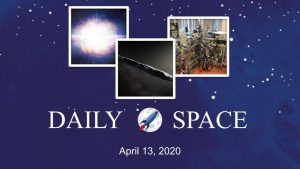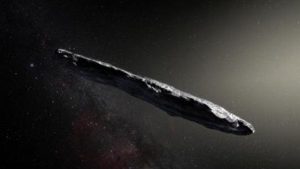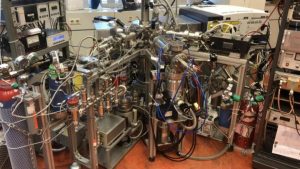
Harvard & Smithsonian today announced the discovery and study of the brightest, most energetic, and likely most massive supernova ever identified, scientists posit new theory possibly Explaining the mysterious interstellar object ‘Oumuamua, and An international team of astronomers has shown in a laboratory at Leiden University that methane can form on icy dust particles in space.
Links
Discovery of most massive supernova ever identified
Explaining the mysterious interstellar object ‘Oumuamua
Methane can form on icy dust particles in space
Transcript
This is the Daily Space for today, Monday, April 13, 2020.
Welcome to the Daily Space, I am your host, Dr Pamela Gay, and I am here to put science in your brain. Most Mondays through Fridays either I or my co-host Annie Wilson will be here, bringing you a quick run down of all that is new in space and astronomy.
Mondays are the day that Nature magazine releases it’s weekly issues, and while there are weeks when these journals don’t carry a lot of the kind of astronomy we cover here, this isn’t one of those weeks! We have 3 great stories, and it all starts with a bang.

CREDIT: M. Weiss
Astronomers from the Harvard-Smithsonian Center for Astrophysics have announced the discovery of the newest supernova to gain the title “Brightest Ever Known.” To be fair, as long as we keep building telescopes to peer at more and more distant corners of the universe, we are going to keep finding new things that are bigger, smaller, and otherwise more extreme than previously seen.
This particular supernova, SN2016aps, was found using Pan-STARRS, and has been studied for 4 years using a mix of new images, and old data from prior to the supernova that allowed them to look for the earliest signs of the supernova going off. They found that SN2016aps was 500 times more luminous than a normal supernova.
To create this massive supernova, the progenerator to SN2016aps had to be a massive, at least 100 times the mass of our Sun. This doesn’t mean the star had to start out that big, and in fact the team believes this object came from the merger of two stars that released a massive shell of gas and dust in the final years before their explosion. This created a system with a single star with an unusually high amount of hydrogen gas, and material to be slammed into.
Early in our universe, star formation was much more common, and these kinds of mergers of massive stars into more massive stars may have also been more common. I look forward to seeing what exactly will be discovered when the Vera Rubin Observatory’s LSST comes online. Its massive mirror will survey the sky and help us maybe find a “brightest supernovae” that will hold its record for a long period of time.

The proliferation of survey telescopes is helping us quantify just what fills our sky and flies through our solar system. Recently, we’ve started turning up extrasolar asteroids and comets as they stumble into our system. Asteroid Oumuamua is one of those objects, and it’s unusual shape brought no end of confusion and speculation to its discovery. Shaped like a needle or cigar, Oumuamua made people think of the spacecraft from Rendezvous with Rama. We just haven’t seen anything this long and skinny before, and spacecraft seemed like as valid an idea as any other, and while the least probable explanation, it is at least understandable. Physical models… well they were harder to come up with.
But one team did manage to find a way. In a new paper with led author Yun Zhang, it’s postulated that as Oumuamua passed near its parent star, it was partiatially tidally disrupted, and the resulting crumbles were stretched out into a broken elongated cloud, until it gravitationally re-solidified into the object we see today.

We know that comets break up – we’ve seen both Comet Atlas and Borisov shatter in the past couple weeks – and it is reasonable to believe that asteroids can and have undergone this same process.
This paints us a picture or Oumuamua being a tortured asteroid that was stretched beyond breaking, but held in a new form. This process was likely part of what sent the object on an escape trajectory, and it is because of the asteroid-breaking event that Oumuamua was able to visit us.
This is one more fable teaching us that sometimes you have to undergo hard times and pain to get somewhere amazing – a message we kind of need today.

Our last story of the day, I’d like to share that the astronomers at Leiden University have finally been able to create methane ice in an artificial environment designed to mimic the conditions found in interstellar molecular clouds. In a containment system, they created both an ultrahigh vacuum environment and the necessary low temperatures – temperatures of -263C or -442F.
<———————>
As part of helping keep us all occupied in these really weird times, we’re going to be hosting a lot of additional content on our Twitch channel, and we want to remind you that CosmoQuest has an active community on Discord where you can talk science, volunteer for various projects, and even find other people to join you in playing some online games. You can find links to everything that is going on at CosmoQuest.org.Thank you all for listening. Today’s script was written by Pamela Gay, and the Daily Space is produced by Susie Murph. The Daily Space is a product of the Planetary Science Institute, a 501(c)3 non profit dedicated to exploring our Solar System and beyond. We are here thanks to the generous contributions of people like you. The best way you can support us is through Patreon.com/cosmoquestx Like us? Please share us! You never know whose life you can change by adding a daily dose of science.


 We record most shows live, on Twitch. Follow us today to get alerts when we go live.
We record most shows live, on Twitch. Follow us today to get alerts when we go live.